
The John Quincy Adams Birthplace is a historic house at 141 Franklin Street in Quincy, Massachusetts. It is the saltbox home in which the sixth United States President, John Quincy Adams, was born in 1767. The family lived in this home during the time John Adams helped found the United States with his work on the Declaration of Independence and the American Revolutionary War. His own birthplace is only 75 feet (23 m) away, on the same property.
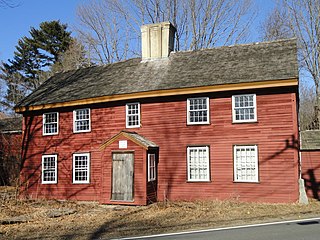
The Benjamin Abbot House or Abbot Homestead is a historic house at 9 Andover Street in Andover, Massachusetts, USA. The house was built in 1711. It was listed on the National Register of Historic Places in 1975.

The Col. John Osgood House is a historic late First Period house in North Andover, Massachusetts. The original part of the house, its left side, was built c. 1720. A second, similar building was then attached to the right side of the chimney at a later date, demonstrating an unusual method of joining the two structures. The house was listed on the National Register of Historic Places in 1990.

The Brown–Stow House or Ichabod Stow House is a historic First Period house in Stow, Massachusetts. The oldest portion of this two-story timber-frame house was probably built early in the 18th century, and consisted of a single "cell" three bays wide, two stories high, with what is now the central chimney in a side bay. During the 18th century it was expanded twice, adding a second cell and a rear leanto. It has had two modest 20th century additions. The house underwent a major restoration in the 1950s to return it to an 18th-century appearance. The house was probably built by Boaz Brown, who acquired the property in 1699 and died in 1711.
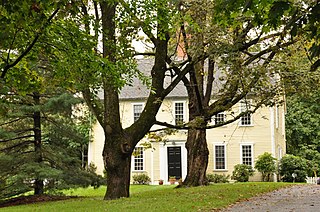
The Rev. Samuel Woodward House is a historic house located at 19 Concord Road in Weston, Massachusetts. Built in 1753, it is a well-preserved example of mid-18th century Georgian architecture. It has also been home to a succession of people significant to the history of the town. It was listed on the National Register of Historic Places in 1976, and was included in Weston's Boston Post Road Historic District in 1983.
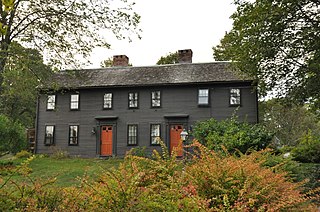
The Jabez Weston House is a historic house in Reading, Massachusetts. The older portion of this 2+1⁄2-story timber-frame house was built c. 1779 in a late-Georgian early-Federalist style. This portion consisted of a five bay section with a centrally located front door. Sometime, an eastern extension added three bays and a second entrance, converting the building into a two family residence. The property belonged to the Weston family, who were early settlers of the area.

The Richard Nichols House is a historic late First Period house at 483 Franklin Street in Reading, Massachusetts, United States. It is a 2+1⁄2-story wood-frame structure, six bays wide, with a side-gable roof, clapboard siding, rubblestone foundation, and an entry in the third bay from the left, with a chimney behind. The oldest portion of this house, probably a three-bay section with chimney, was built c. 1733, and expanded to five, and then six, bays later in the 18th century. The house, along with extensive landholdings, remained in the locally prominent Nichols family until the late 19th century.

The William McFarland House is an historic house at 525 Salisbury Street in Worcester, Massachusetts. It is a 1+1⁄2-story wood-frame Cape style structure, with a side-gable roof, central chimney, clapboard siding, and rubblestone foundation. Its main facade is three bays wide, slightly asymmetrical, with a center entrance flanked by pilasters and topped by a modest entablature. Probably built sometime between 1743 and 1759, the house is one of Worcester's oldest surviving structures. It was probably built by William McFarland, Sr., a lieutenant in the American Revolutionary War, and remained in that family for over 100 years.

The House at 107 William Street in Stoneham, Massachusetts, is a well-preserved early Greek Revival cottage. Built in the 1820s, it is a 1+1⁄2-story wood-frame house, five bays wide, with a side-gable roof, clapboard siding, and a granite foundation. It has a projecting central entry and an ell on its east side, set on a brick foundation. The ell has a second entry, indicating it may have been used as a shop. The main entry has sidelights, and both entries have a narrow transom. It is one of a small number of surviving buildings of a larger cluster that once stood near the junction of William and Main Streets.

The Elias Boardman House is a historic house at 34 Salem Street in Wakefield, Massachusetts. Built in 1790, it is one of the city's most elaborate examples of Federal period architecture. It was built by Elias Boardman, and was dubbed Boardman's Folly for its extravagance. It was listed on the National Register of Historic Places in 1989.

The Nathaniel Cowdry House is a historic house at 71 Prospect Street in Wakefield, Massachusetts. Built about 1764, it is one of Wakefield's oldest buildings, built by a member of the locally prominent Cowdry family, who were early settlers. The house was listed on the National Register of Historic Places in 1989.

The Captain Goodwin–James Eustis House is a historic house in Wakefield, Massachusetts. Built about 1760 and enlarged around 1830, it is a good local example of Greek Revival architecture, which was owned by a prominent local businessman and civic leader. The house was listed on the National Register of Historic Places on March 2, 1990, where it is listed as the "Captain Goodwin–James Custis House".

The House at 23 Lawrence Street in Wakefield, Massachusetts is a good example of a late 19th-century high-style Colonial Revival house. Built in the late 1890s, it was listed on the National Register of Historic Places in 1989.
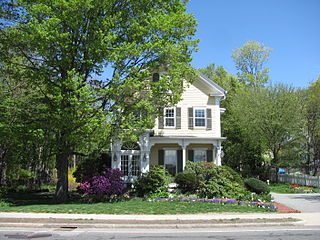
The House at 190 Main Street, also known as the William F. Young House, is a historic house at 190 Main Street in Wakefield, Massachusetts. The exact construction date of the 2+1⁄2-story wood-frame house is uncertain: it follows a traditional three-bay side-hall plan, but was also extensively remodeled sometime before 1870 with Italianate styling, probably by William F. Young, a commuter who worked at a grocery firm in Boston. It has a round-arch window in the front gable end, and its porch features narrow chamfered posts topped by a flat arched frieze. The main entry portico is closed in, and it and the porch feature decorative brackets.

The House at 196 Main Street is a historic house located at 196 Main Street in Wakefield, Massachusetts.

The House at 28 Wiley Street in Wakefield, Massachusetts is an unusual Federal or Georgian style house. It is built of brick, a rare construction material in pre-Revolutionary Wakefield. It appears to have been built as an addition to another house, which has since been destroyed. Built into a hill, it presents 1.5 stories in front, and 2.5 stories in back. It has a tradition five bay main facade with a central door, which was embellished with a Federal style surround sometime after its initial construction. The house was probably built for a member of the Wiley family.

The Josiah Cowles House is a historic house at 184 Marion Avenue, in the Plantsville section of Southington, Connecticut. Built in the mid-18th century, it is a well-preserved local example of Georgian architecture. It was listed on the National Register of Historic Places in 1989. It presently houses a bed and breakfast inn.

The Oliver House, also known as the Smith-Oliver House, is a historic house at 58 Oak Street in Wakefield, Massachusetts. Probably built in the late 18th century, this Federal period house is distinctive for its association with the now-suburban area's agrarian past, and as a two-family residence of the period, with two "Beverly jogs". The house was listed on the National Register of Historic Places in 2014.

The William Peabody House is a historic house on North River Road in Milford, New Hampshire. This 2+1⁄2-story wood-frame house was built c. 1740 by William Peabody, the first English settler of the Milford area, and remains a good example of Georgian residential architecture despite a 1973 fire. The house was listed on the National Register of Historic Places in 1979.
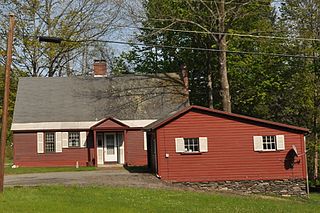
The William Harris House, also known locally as the Joseph Caruso House, is a historic house on Western Avenue in Brattleboro, Vermont. Built in 1768, this Cape-style house is believed to be the oldest surviving building in the town, and one of the oldest in the entire state. It was listed on the National Register of Historic Places in 1978.























